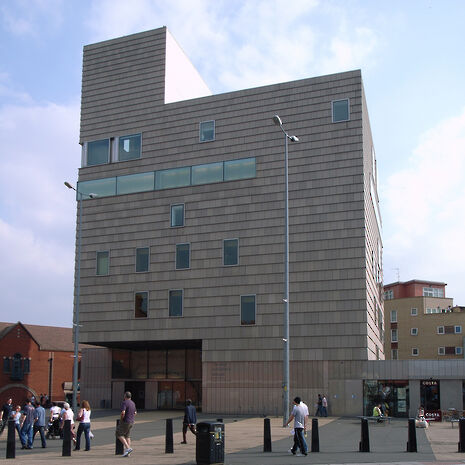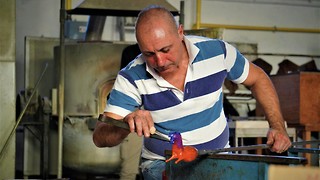We should fight to save regional art galleries but learn lessons too
When it comes to building art galleries around the country, we need to be realistic argues Patrick Wernham

In terms of the changes that have taken place between 2000 and the present day, it might not seem like the most significant. Headlines have been dominated by the divisiveness that characterised Donald Trump’s election and the Brexit campaign, which stands in clear contrast to the forward-looking liberalism embodied by Tony Blair and Bill Clinton. Yet, on a more modest level, the potential closure of New Art Gallery Walsall is just as illustrative of the changing state of the world, and should not be overlooked.
The gallery, opened in 2000 as a product of the optimism (and cash) that permeated the New Labour years, was meant to bring the ‘Bilbao effect’ to Walsall, a post-industrial town in the heart of the Black Country. The Spanish city was also suffering economically before the opening of the Guggenheim Museum in 1997, which sparked something of a turnaround in its fortunes, not least because of the number of tourists the gallery attracted.
Indeed, for a few years it looked like it might work in Walsall. Visitor numbers were high and the shops nearby were taking in more than they had for years. But even though the gallery still attracts 172,000 visitors a year, it is threatened by Walsall Council’s need to save £86m by 2020. Gallery staff are in a struggle to keep the place open at all, with councillors arguing that in the context of swinging cuts to local authority budgets, other public services should be prioritised. The future looks rather bleak for New Art Gallery Walsall.
And what a travesty that would be. The building itself, designed by the architects Caruso St John, is a work of art. It houses the extraordinary Garman Ryan Collection, featuring works by Jacob Epstein, Constable, Van Gogh, and Renoir among others. Given that it was donated to the people of Walsall by Epstein’s wife, Kathleen Garman, who specified that it should not be broken up, it is unclear what would happen to the collection if the gallery closed. It also devotes two floors to showcasing contemporary work: past exhibitions have included works by Tracey Emin, Barbara Hepworth, and Louise Bourgeois.
It is depressing to think that the people of Walsall, as well as surrounding areas, might no longer have access to such wonderful artwork. Many people simply don’t have the time or money to travel to London or elsewhere, and so the end of the New Art Gallery might mean the end of their engagement with the art world.
This is particularly true of generations to come. I remember going to creative art classes that were put on for children, which provided a fun and accessible way of engaging with the gallery. If it were to go, one can only despondently wonder how many people who may have loved the art will never even come across it.
The gallery’s closure would also be of symbolic importance. It would send a message that art, and public access to it, is something that can only be sustained in times of affluence. It is something that can only be sustained in wealthier areas of the country: in other words, London. If you’re from somewhere poorer, somewhere less glamorous, then ready access to fantastic pieces of art isn’t for you.
This is a time, then, to feel rather gloomy. But it’s also a time to take stock, and wonder what the potential closure of the gallery tells us about regional art spaces more generally. Self-evidently, what is clear is that these things are not easy. Art galleries are expensive things to run, and will not always be that popular. It turns out that the real world isn’t Field of Dreams, and Kevin Costner’s philosophy can’t be applied to everything: if you build a bold, award-winning art gallery, they won’t necessarily come.
It also raises the point that some places aren’t particularly well-suited to having a sizeable art gallery. As exciting as the Leather Museum is, there’s not a lot going on in Walsall apart from the gallery: it is not going to attract of lot of passing visitors. Even for those who want the gallery, it’s not all that easy to get to. On public transport, most people will have to take at least two journeys, and even then it’s half an hour away from the centre of Birmingham.
This point in particular highlights why it is problematic to talk of regional art galleries as some homogeneous entity. Cambridge, for one, does not share many of Walsall’s problems. The University means there is both a large body of students likely to take an interest in the arts, and tourists passing through the city anyway.
“galleries don’t have to be something only found in Zone One, or small towns without many other attractions”
The example of Cambridge proves that we don't have to think in extremes: galleries don’t have to be something only found in Zone One, or small towns without many other attractions. We can, and should, be looking to promote art in other parts of the country, but places where there is a greater chance of it being a success. Cities like Birmingham, Manchester and Leeds all have large populations of their own, have other attractions to pull in potential gallery visitors, and are more accessible on public travel. Building art spaces in cities such as these would allow us to pursue the noble aim of making art accessible, but show an awareness of practical limitations.
It is awful that New Art Gallery Walsall may close. The intentions of those who opened it were admirable, and we should do everything we can to stop such a great space being lost. But we should also learn from the experience. Regional art galleries are glorious things, and should be given the greatest chance of success. When looking at where we can go from here, a little pragmatism wouldn’t go amiss
 Comment / The (Dys)functions of student politics at Cambridge19 January 2026
Comment / The (Dys)functions of student politics at Cambridge19 January 2026 News / Local business in trademark battle with Uni over use of ‘Cambridge’17 January 2026
News / Local business in trademark battle with Uni over use of ‘Cambridge’17 January 2026 Features / Exploring Cambridge’s past, present, and future18 January 2026
Features / Exploring Cambridge’s past, present, and future18 January 2026 News / Your Party protesters rally against US action in Venezuela19 January 2026
News / Your Party protesters rally against US action in Venezuela19 January 2026 Arts / Exploring Cambridge’s modernist architecture20 January 2026
Arts / Exploring Cambridge’s modernist architecture20 January 2026







